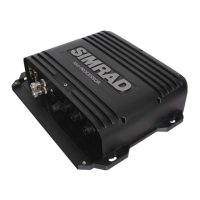| 43
Autopilot | NSO-II Operator Manual
The waves may yaw the boat into an unwanted gybe; this can be hazardous for both the
crew and the mast.
The gybe prevent function will be activated when the actual apparent wind angle
becomes greater than 175° or gets opposite to the set wind angle. More rudder will be
commanded to prevent an unwanted gybe.
The tack and gybe prevent functions are not a guarantee against getting into a hazardous
situation. If the eect of the rudder and/or drive unit is not adequate, a dangerous
situation may occur. Pay particular attention in such situations.
Wind steering and navigation
In Wind Nav the autopilot steers the boat given both wind data
and track data from the NSO-II navigation function.
In Wind Nav mode the autopilot calculates the initial course
change needed to navigate towards the active waypoint, but the
pilot will also utilize the current wind direction in the calculation.
Using the NSO-II in an AP24/AP28 system
Command transfer
If your NSO-II unit is connected to an autopilot system including an
AP24 or AP28 control unit, only one control unit can be active at the
same time. An inactive unit is indicated with an envelope symbol in
the display.
You can take command from an inactive NSO-II unit with active autopilot pop-up by
turning or pressing the OP40 rotary knob.
If the pop-up is not displayed, you can take command from the NSO-II unit by pressing
and holding the OP40 STBD/AUTO key to bring up the mode selection menu, and then
conrming active mode.
Locking remote stations
The AP24/AP28 includes a Remote Lock function that will disable all
other control units. A locked unit is indicated with a key symbol.
When the remote lock function is enabled on AP24/AP28 no transfer
of command to NSO-II or other AP heads on the system can take
place, only the active AP control unit stays in command.
You can only unlock the remote stations from the AP24/AP28 unit in command.
Using the autopilot in an EVC system
When the NSO-II is connected to an EVC system via the SG05, you can take manual control
of the steering irrespective of the autopilot mode.
The mode indicator on the pilot pop-up will be replaced by a dash to indicate EVC
override.
The system will return to NSO-II control in standby mode if no rudder command is given
from the EVC system within a predened period.

